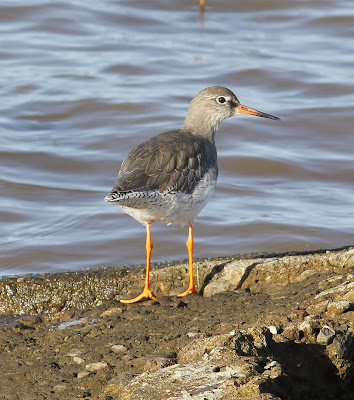I hoped the blows and rain of the last couple of days might have left behind a few waifs and strays at Knott End and Pilling, but nothing of the sort. In fact at Knott End the weather was still kicking up a bit of storm making it difficult for birds and birders. With the strong north westerly at my back getting up river was fine, it was the coming back into the teeth of the wind and frequent showers which took the time.
Not much to show for my efforts on a ‘bins only’ morning when ‘scopes become redundant.
Turnstones are back in better numbers now, both here and across the river at Fleetwood, but I couldn’t see any of the leg-flagged ones of recent years in my count of 19. Not many Oystercatchers on the beach, less than 200 and obviously many had gone upriver to escape the windswept beach. Similarly small numbers of Redshank, a count of less than 20 being pretty pathetic, a total surpassed today by a count of 70 Lapwings sheltering in the clumps of marram grass on the beach. On the sea/in the mouth of the estuary were 15 Eider and 2 Red-breasted Merganser.
Turnstone
Oystercatcher
Amongst the tide wrack below the promenade I found a Rock Pipit, 8 Twite and a single Pied Wagtail.
Rock Pipit
Fluke proved equally quiet where half way along the sea wall I didn’t escape a drenching from a heavy shower. Just 14 Whooper Swans today, some definitely new arrivals in the shape of two family parties with brownish young, four of the young so coffee coloured that I expect their departure from Iceland was delayed until the whole family could make the long flight safely. Good numbers of 120+ Shelduck out there on marsh and on the wildfowler’s pool, with 12 Black-tailed Godwits and 4 Little Egret.
“Small stuff” fighting into the wind - 3 Meadow Pipit, 11 Skylark, 6 Tree Sparrow and 8+ Chaffinch.
Tree Sparrow
Finally, there’s a very sad news story from Yahoo Finance 28th of October 2013, totally unrelated to birds but almost certainly of interest to one or two birders I know who enjoy a glass of wine after a windswept day in the field.
“On Monday global drinks giant Treasury Wine Estates faced a class-action lawsuit from Australian shareholders after oversupply issues forced six million bottles of wine to be poured down the drain. Law firm Maurice Blackburn and class action funder IMF Australia said they were preparing a shareholder lawsuit against Treasury, the wine business spun off from Australian beverages giant Foster's in 2011. The glut-hit wine company, which owns major brands including Penfolds, Rosemount Estate and Wolf Blass, shocked the market in July when it unveiled Aus$160 million (£95 million) in write-downs related to oversupply problems in the United States. "The impairment included a Aus$33 million provision to pour six million bottles of out-of-date wine down the drain," IMF said in a joint statement with their lawyers”.
A Glass of Wine
I shall leave blog readers to contemplate this wretched and depressing story while I go and drown my sorrows, but there’s cheerier news from Another Bird Blog very soon.
Linking today to Stewart's Bird Gallery in Australia. Hey Stewart, try and rescue some of that wine.
Linking today to Stewart's Bird Gallery in Australia. Hey Stewart, try and rescue some of that wine.




















































.jpg)












